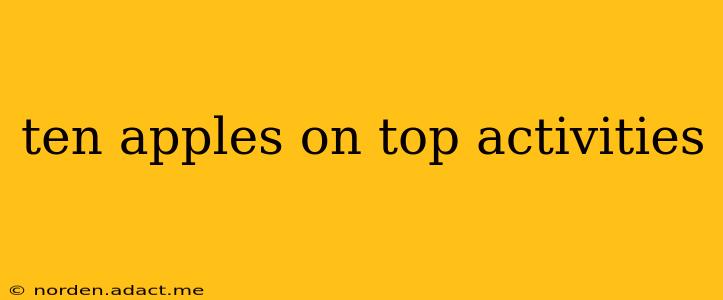"Ten Apples on Top!" is more than just a fun children's book; it's a springboard for countless engaging activities that foster early literacy, math skills, and imaginative play. This beloved story, with its rhythmic repetition and playful illustrations, offers a rich tapestry of opportunities for learning and fun. Let's explore some creative and enriching activities you can do with this classic tale.
What are some ways to act out the story of Ten Apples on Top?
Acting out the story is a fantastic way to bring "Ten Apples on Top" to life! You can use real apples (or any other suitable objects like blocks, stuffed animals, or even children themselves!) to physically represent the apples. Each child can take turns placing an apple on their head, building the stack as the story progresses. For added fun, incorporate dramatic expressions and actions – perhaps a wobbly walk to emphasize the precarious stack! You can even use this as an opportunity to introduce concepts of balance and gravity.
How can I use Ten Apples on Top to teach counting and number recognition?
The repetitive counting aspect of "Ten Apples on Top" is perfect for reinforcing number recognition and counting skills. You can use the story as a base for various number-related activities. Try these:
- Counting objects: Use objects other than apples to build the stack – blocks, toys, even fingers! Count aloud together as you add and remove each item.
- Number matching games: Create cards with numbers 1-10 and have children match them to the appropriate number of objects as you read the story.
- Counting backwards: Reverse the storytelling and have children remove apples one by one, counting down from ten. This helps with subtractive thinking.
What are some creative ways to extend the Ten Apples on Top story?
The beauty of "Ten Apples on Top" lies in its adaptability. It's not just about apples; it's about stacking anything on top of something else! Extend the story by:
- Changing the objects: Replace apples with different objects like oranges, books, or even toys. This promotes flexibility and creativity.
- Adding new characters: Introduce new characters into the story and have them participate in the stacking game. Encourage children to think of new roles and interactions.
- Creative writing: Have children write their own versions of the story, featuring their favorite objects and characters.
How can I use Ten Apples on Top to help with early literacy skills?
Beyond counting, "Ten Apples on Top" is an excellent tool for developing early literacy skills:
- Rhyme and rhythm: The rhythmic repetition of the story is ideal for introducing the concepts of rhyme and rhythm in language. Pay attention to the rhyming words and encourage children to clap along with the rhythm.
- Vocabulary building: Expand vocabulary by introducing synonyms for "wobble" and other words used in the story.
- Predictable text: The repetitive nature of the book makes it perfect for developing predictive reading skills. Children learn to anticipate what will happen next.
What other themes or concepts can be explored using Ten Apples on Top?
"Ten Apples on Top" can be a starting point for exploring various themes and concepts:
- Balance and gravity: The act of stacking objects naturally leads to discussions about balance and gravity, introducing rudimentary scientific concepts in a fun way.
- Cooperation and teamwork: If done in a group, this activity promotes cooperation and teamwork as children work together to build the stack.
- Problem-solving: When the stack falls, it becomes a problem-solving opportunity. Children can discuss strategies to build a more stable stack next time.
By utilizing these activities, you transform "Ten Apples on Top" from a simple children's book into a rich, interactive learning experience. The versatility of the story allows you to tailor activities to suit different age groups and learning styles, making it an invaluable tool for early childhood education and fostering a love of reading and learning. Remember to always adapt and adjust the activities to suit the children's age and abilities. Have fun!
